
The Best of Ireland
Mike and Judy Henderson
May 26 - June 8, 2018
I'm going to leave the map at the beginning of each web page so you have a reference as to where we are.

+++++++++++++++++++++++++++++++++++++++++++++++++++
6/1/2018 (Friday) We head south today, back into the Republic of Ireland. Our first stop was at St. Columba's Church which is just outside of Sligo. W.B. Yeats, the poet and writer, is buried in the graveyard at St. Columba.
Here's a view of the church.
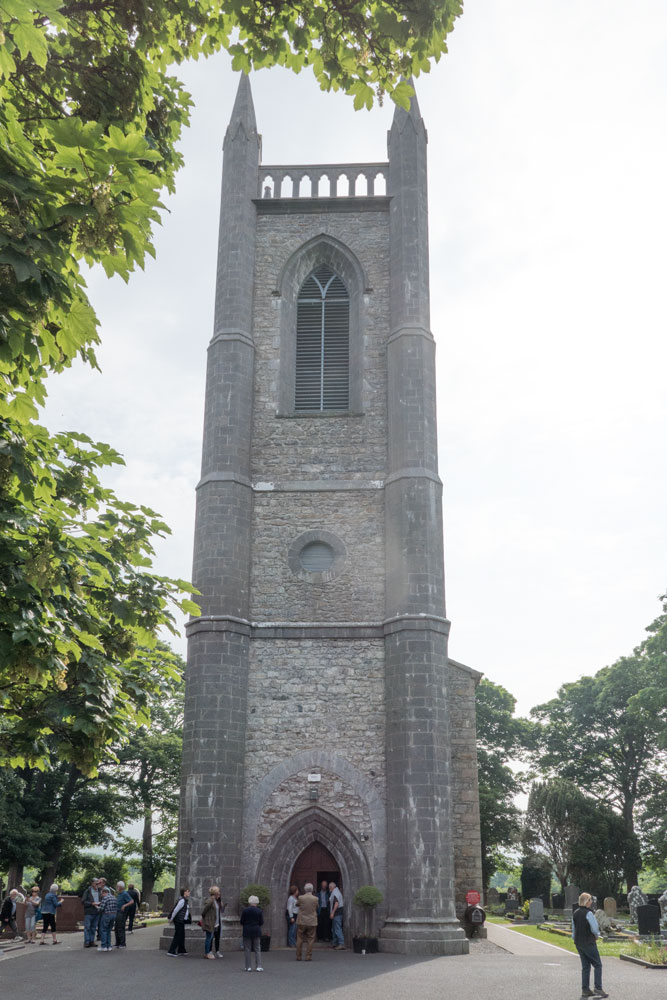
And the interior. The church is in pretty good condition. There's a gift shop on the property, and the church has signs asking visitors to contribute so I expect they have the finances to keep the church up. Having Yeats buried in their graveyard has probably been a windfall for the church.

Yeats' grave.

In the church parking lot there's a statue which incorporates some of Yeats' words. I don't know the message of the work, however.
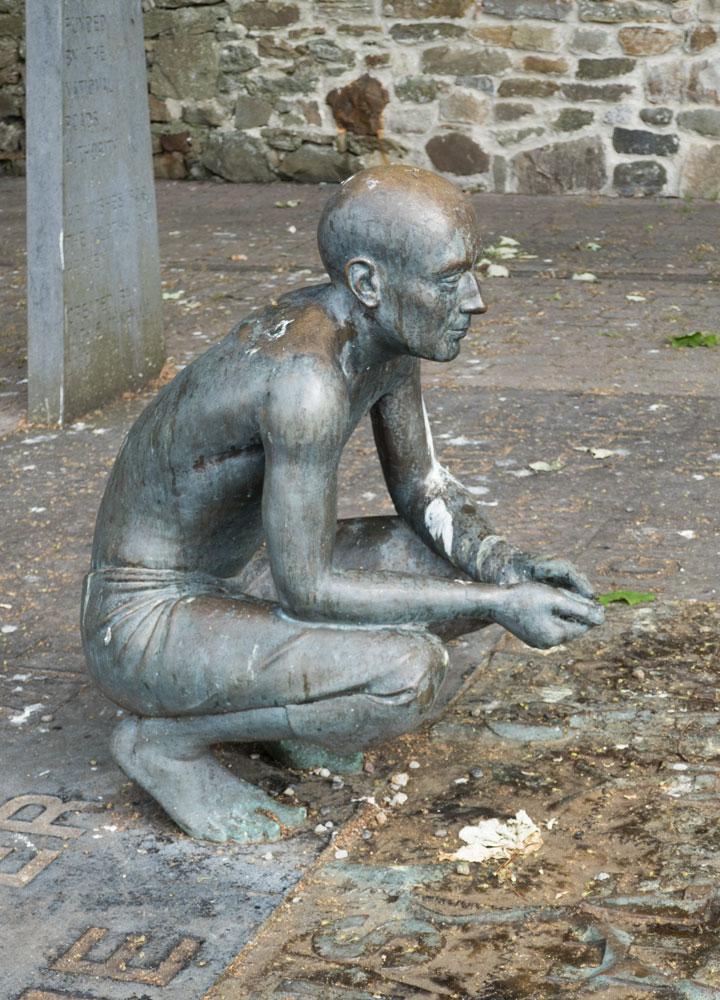
After we left the Yeats grave, we headed to Knock, a town in Ireland. There was a purported religious apparition outside of Knock and now there are several churches at the site. Here's the protestant church where the apparition is reported to have happened.

Attached to the church is a chapel with figures to represent the purported apparition. I thought I had heard of many of the places where religious apparitions had occurred, but I had never heard of Knock.
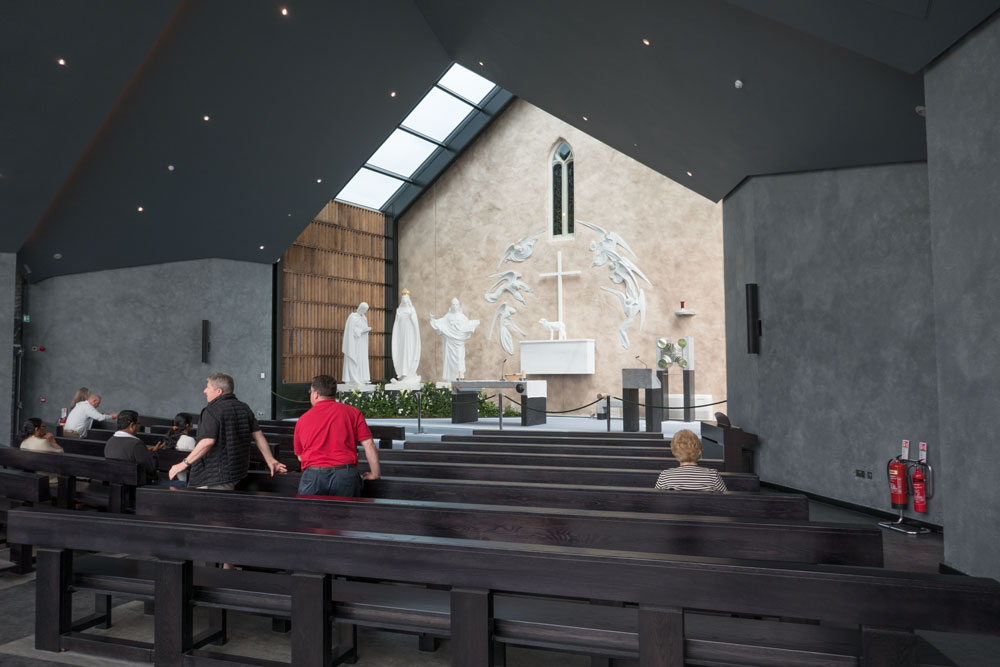
I don't know much about the purported apparition so you'll have to read the link above to learn more.
Also on the site is a Catholic basilica. It's huge. Wikipedia says it can hold 10,000 people.
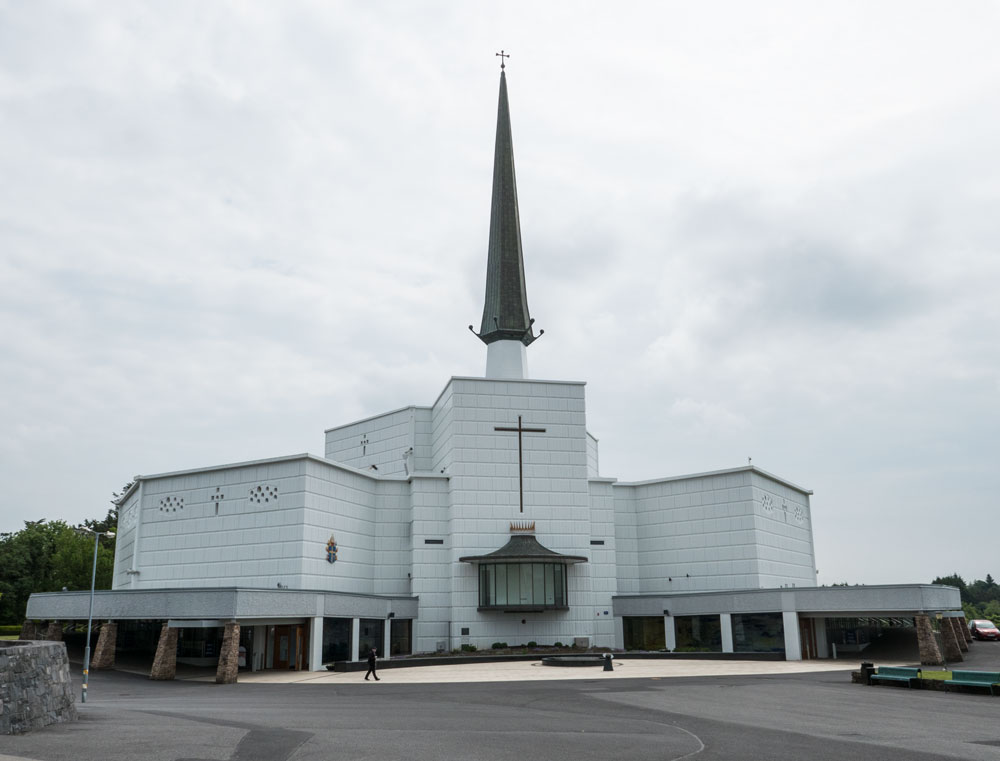
This is a view of the altar and the giant mosaic mural behind the altar. The mural depicts the purported apparition.
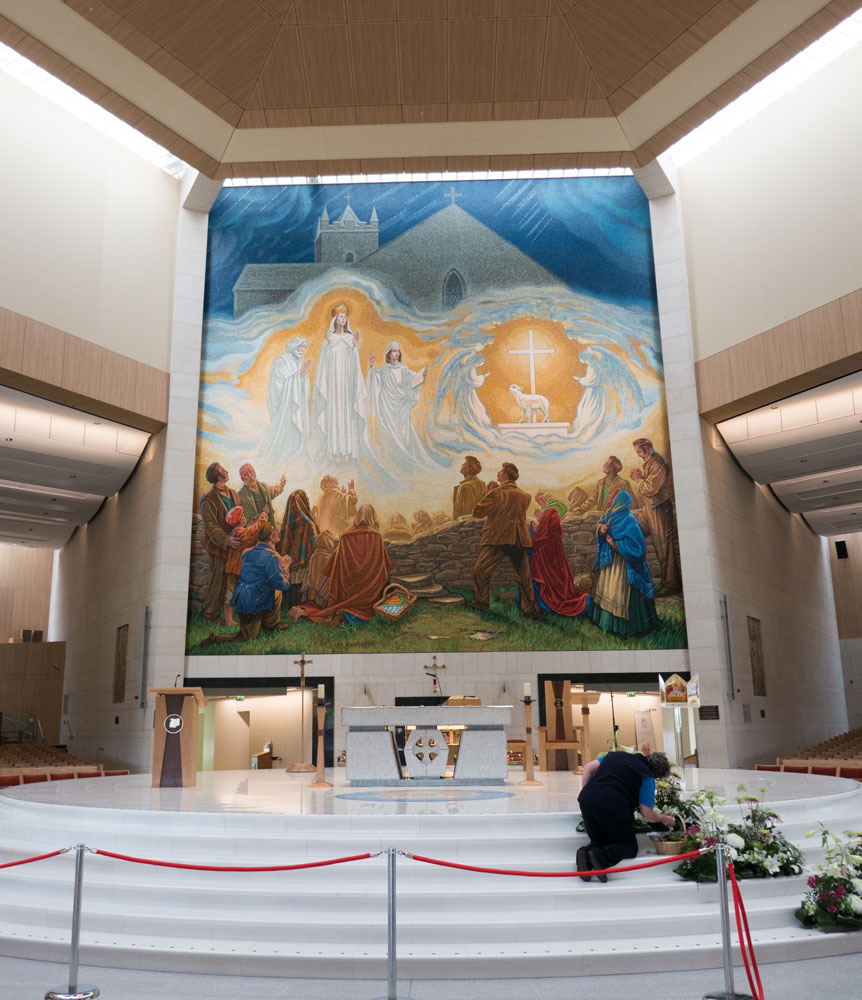
After this visit, we headed to Galway. We were a bit late because of an automobile accident - all traffic was routed around it in a long detour. We were only in Galway for a short time - just long enough for lunch. Galway appears to be a real tourist town. There were lots of pubs and restaurants on the street we were on, and a lot of people - too many people for just locals on a Friday afternoon.
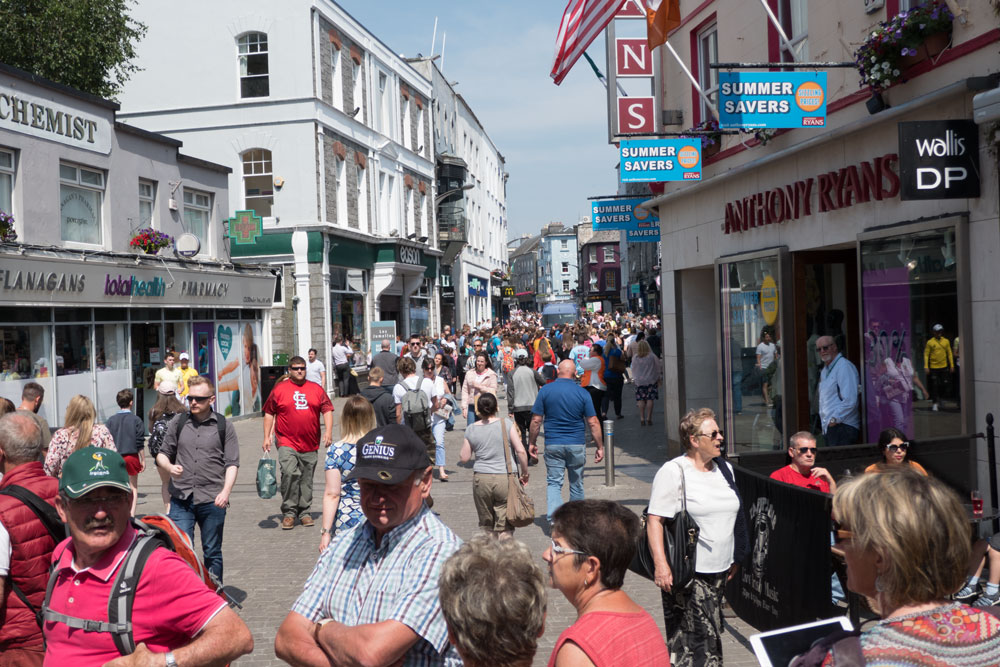
Leaving the main district of Galway, the bus took us to the river - the River Corrib - that flows through Galway, and we caught a tour boat.
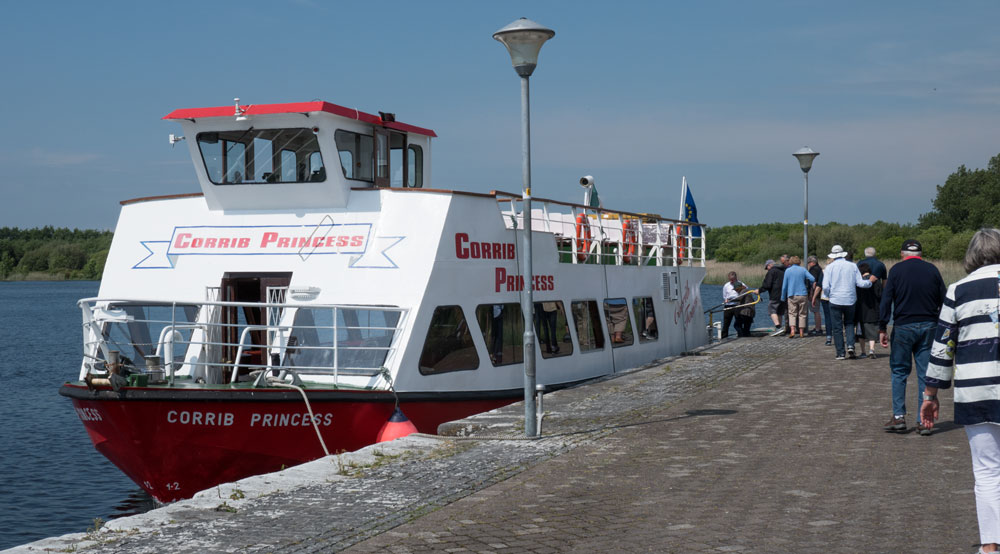
The Corrib is a tidal river and there's a weir that controls the water level in the river. You can see the weir in the following picture. It's the structure that looks something like a pedestrian bridge. You can see that the level of the river is much lower on the other side of the weir.
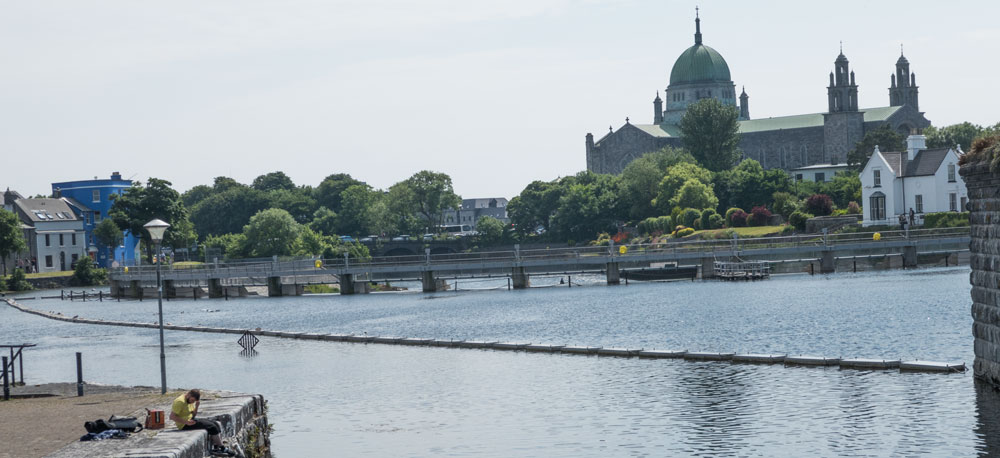
We sailed up the river Corrib to the Lough Corrib (a lake) and then back to our hotel, Glenlo Abbey. Here's a map of the area showing the river and the lake.
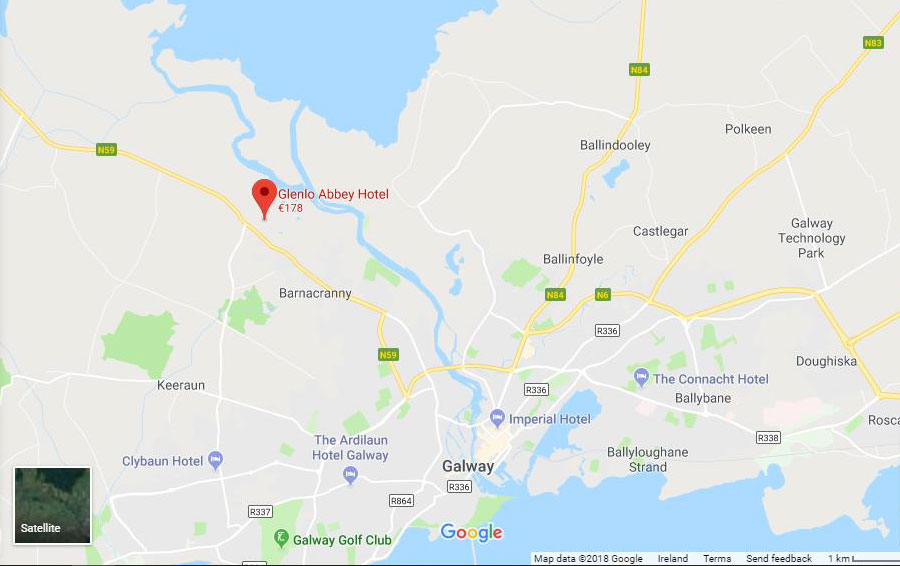
This view of the abbey is taken from the area of the river. There's a nine hole golf course associated with the hotel and we'll try to play it tomorrow. After we checked in we discovered that, although it's a nice hotel, the rooms do not have air conditioning and the Internet access is painfully slow.
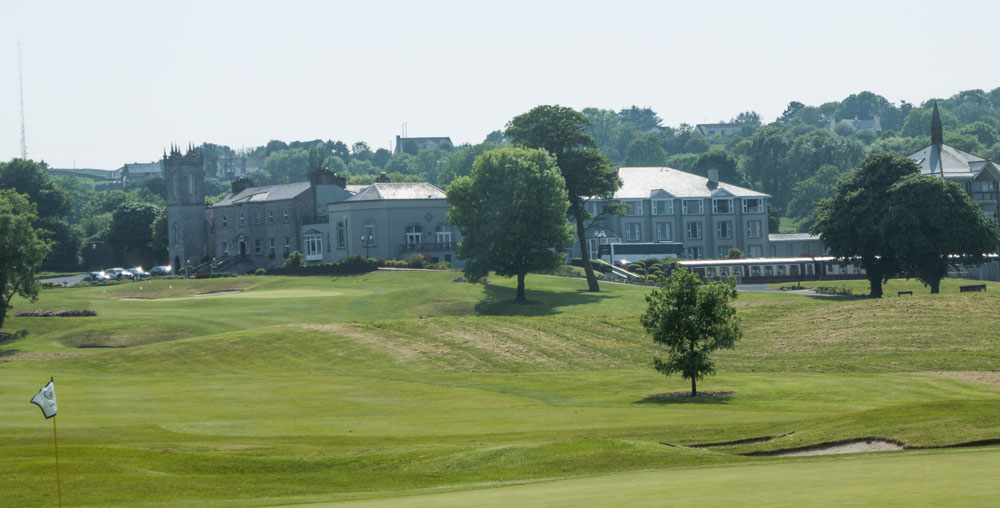
The hotel has a restaurant in two dining cars from the Orient Express. The cars date back to the 1920's or so but they have been renovated. Here are the cars, backed by the sunset (Picture by Michael Sullivan, used with permission).
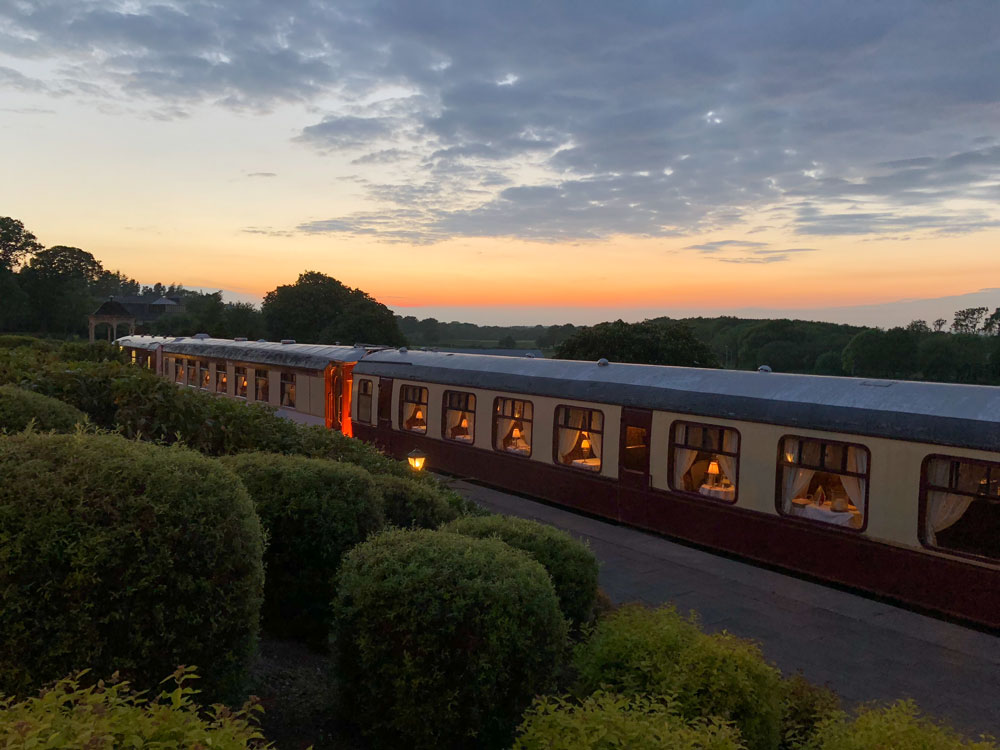
This is a view of the interior of one of the cars.
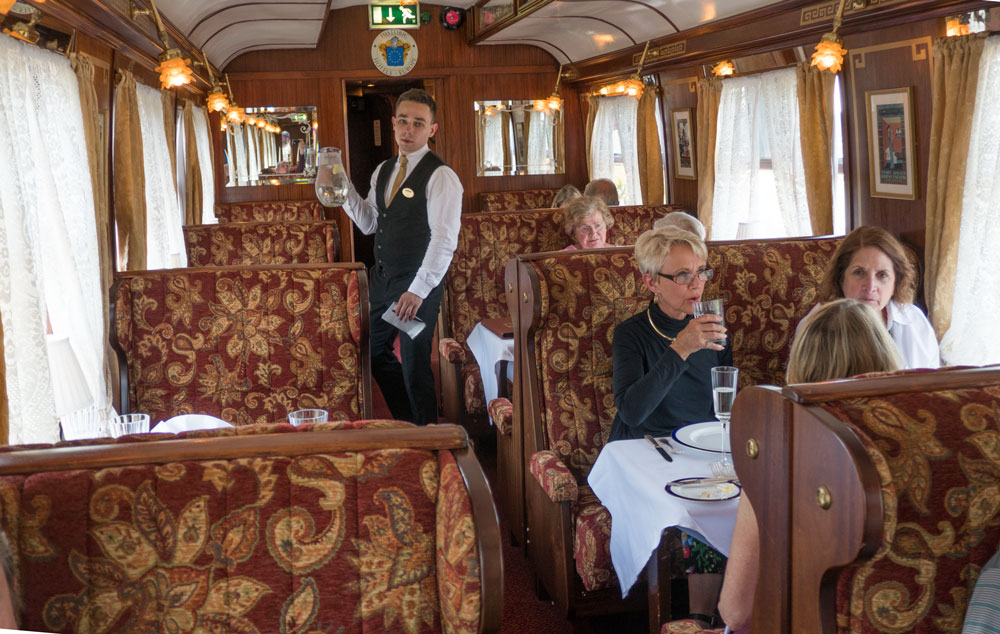
And Judy and I are at one of the tables.
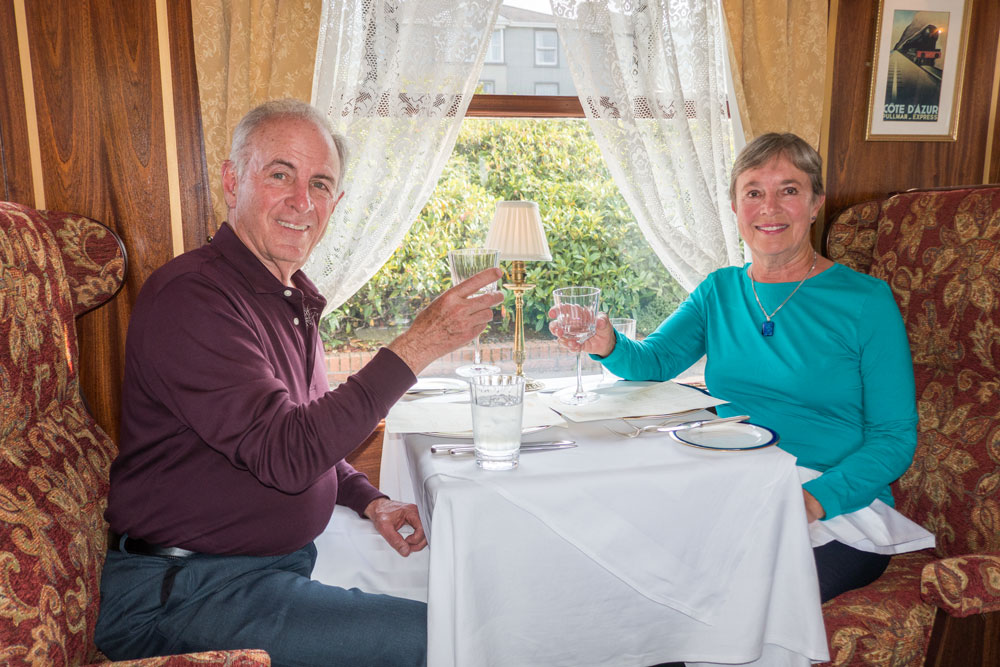
++++++++++++++++++++++++++++++++++++++++++++++++++++++++++++
6/2/2018 (Saturday) The tour today goes to the Connemara area and Kylemore Abbey, but Judy and I decided that we'd play a round of golf. Its only a 9 hole course here, but it looks like a good course.
Here's the front of the hotel with the Tauck bus and the rest of the tour group getting on the bus.
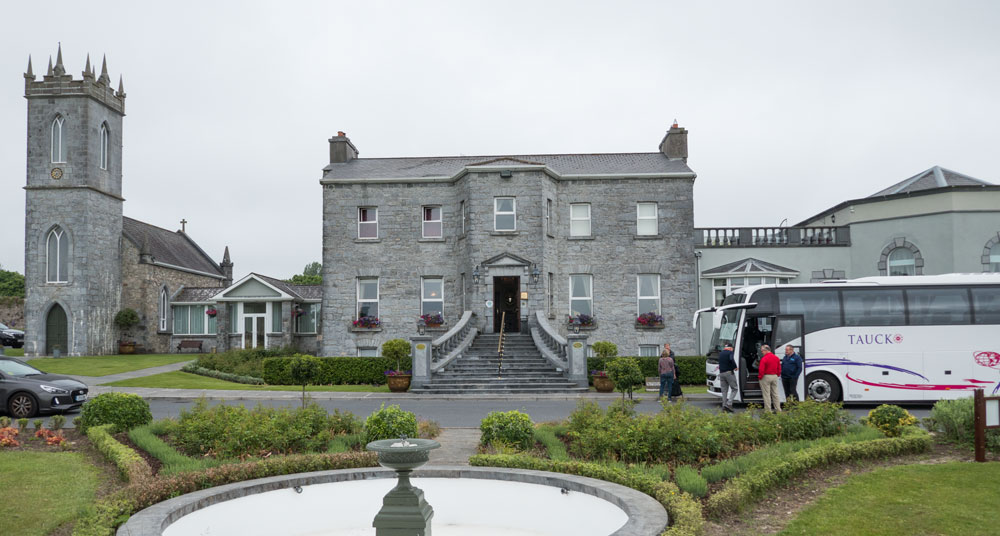
The pro shop had our buggy and clubs ready for us. The clubs were very nice - the latest clubs and almost new.
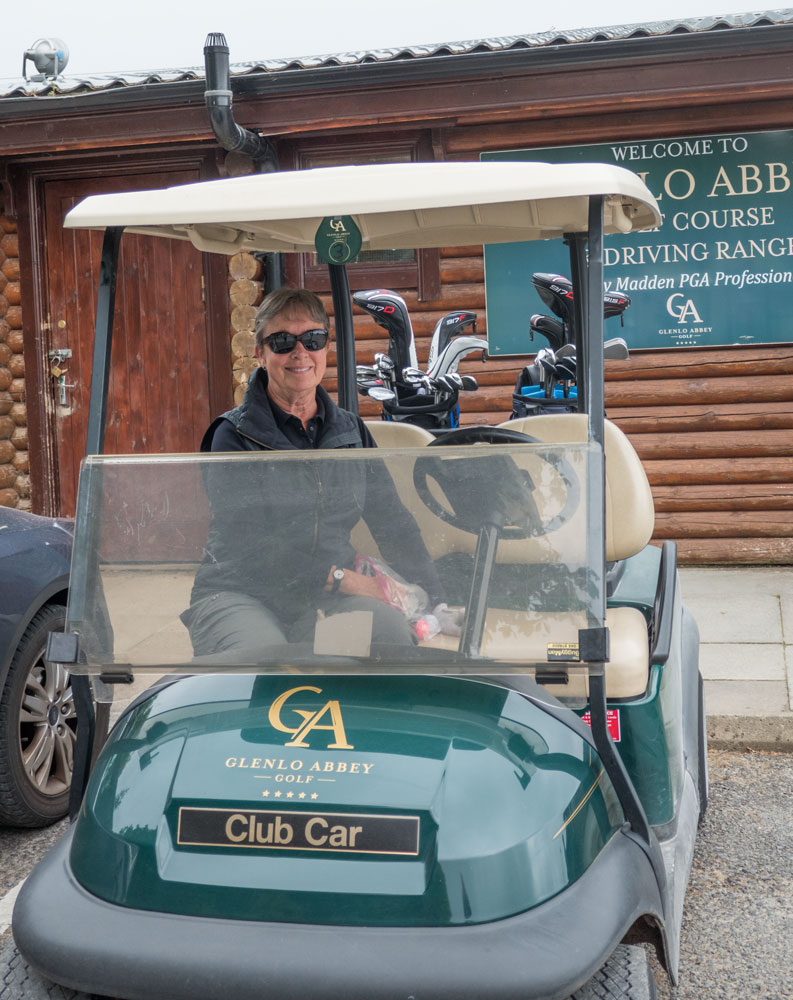
I didn't take many pictures on the course, but here's Judy teeing off on the second hole.
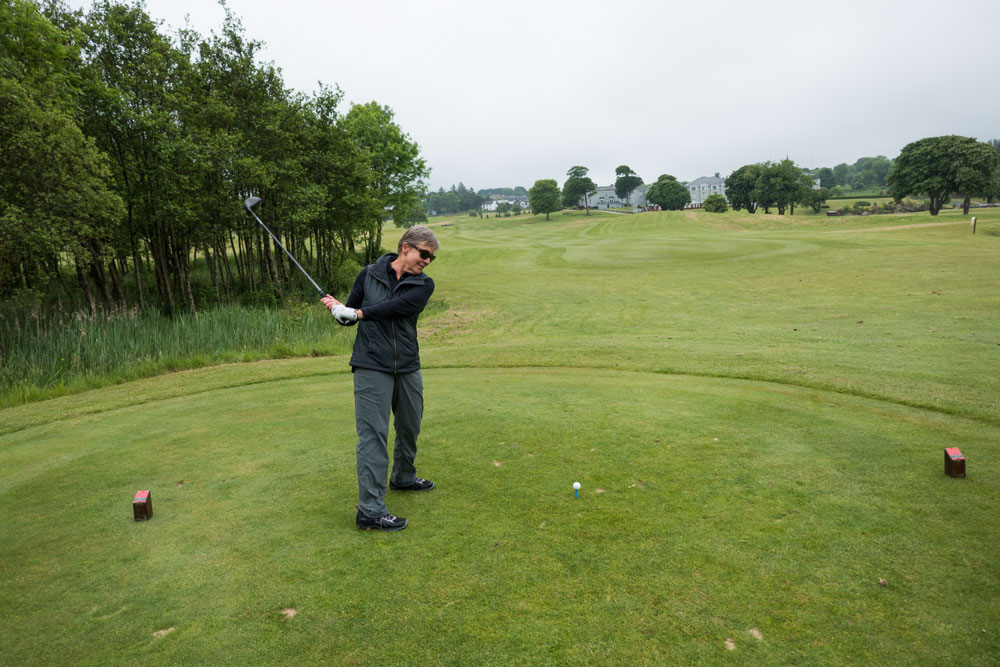
The course was more difficult than it appeared. They had cut the grass on the rough, but the dry cuttings were lying in bunches, and a ball could easily hide under those tufts of dried grass, or in the middle of round areas of high rough stuff including prickly gorse.
When we finished the nine holes, we could have gone back and played them again to make 18, but it was misting and rain was predicted. So we headed back to the pro shop to turn in the buggy and clubs.
Here's Judy with one of the pro shop workers after we turned the clubs in.
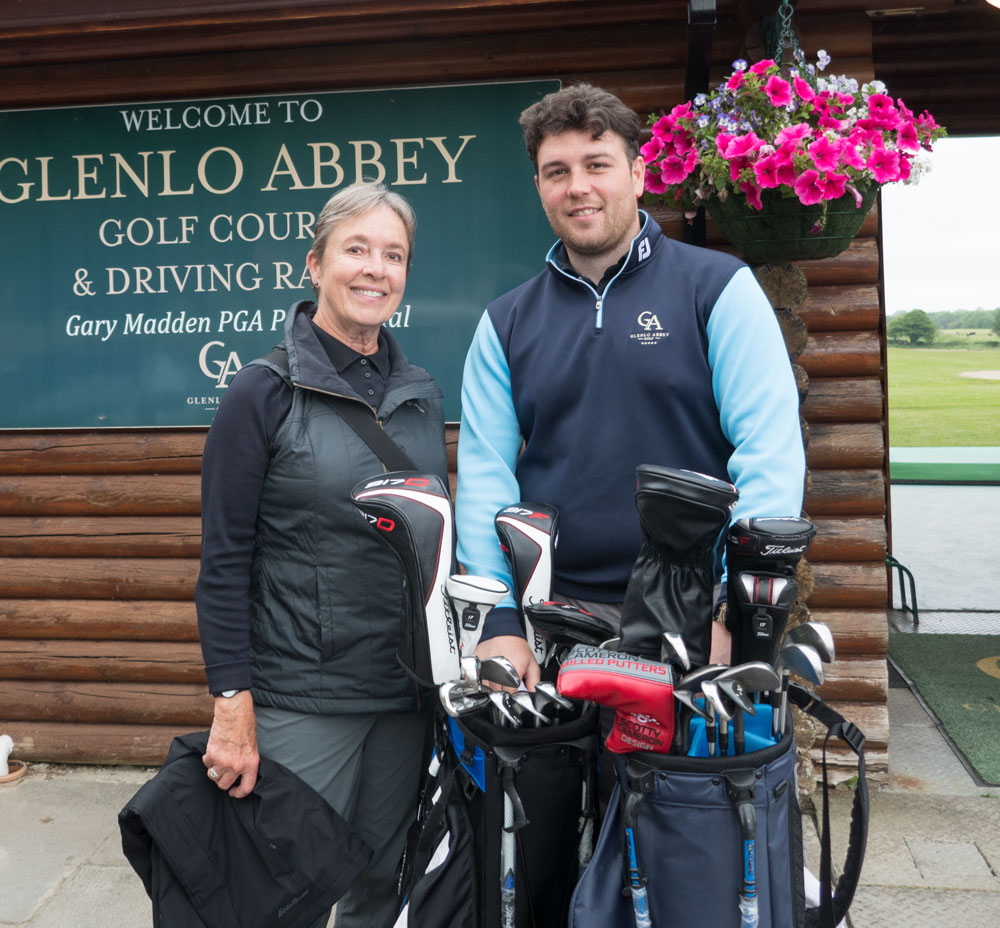
Although we did not go on the bus tour this morning, Michael Sullivan did, and he took pictures which he sent to me. Here are some of his pictures. This is Kylemore Abbey.
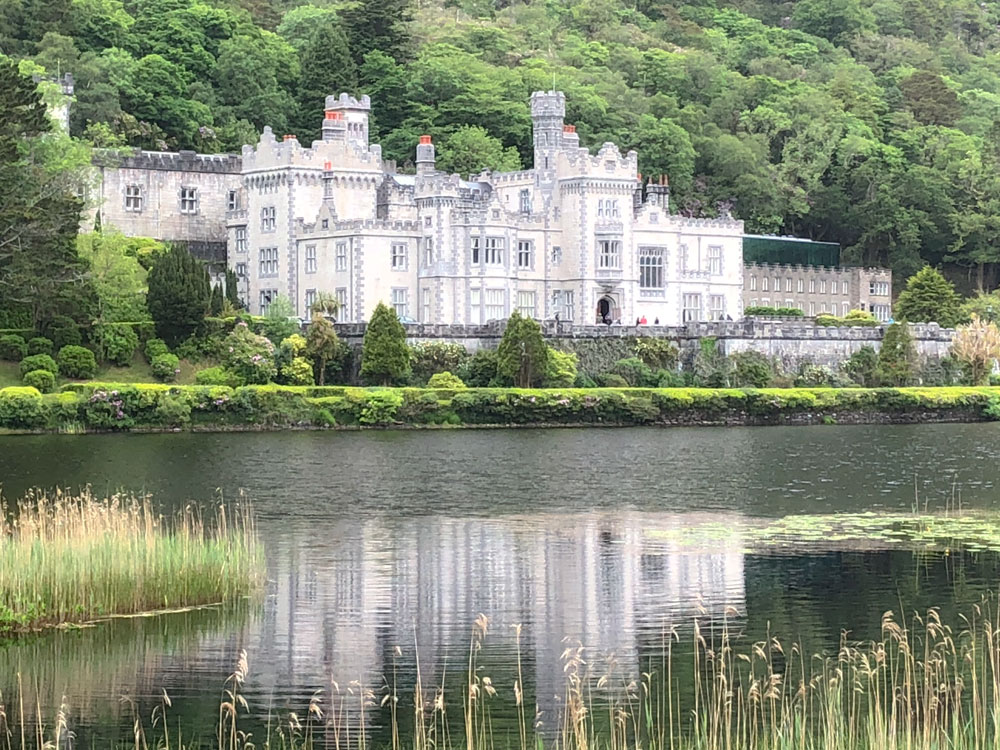
Here are David and Michael in front of the abbey.

Michael and I both thought this tree made an interesting picture. The location information in the picture says Kylemore. I think this area must get strong winds from the west and those winds can shape the trees. In California we have similar trees on the coastline.
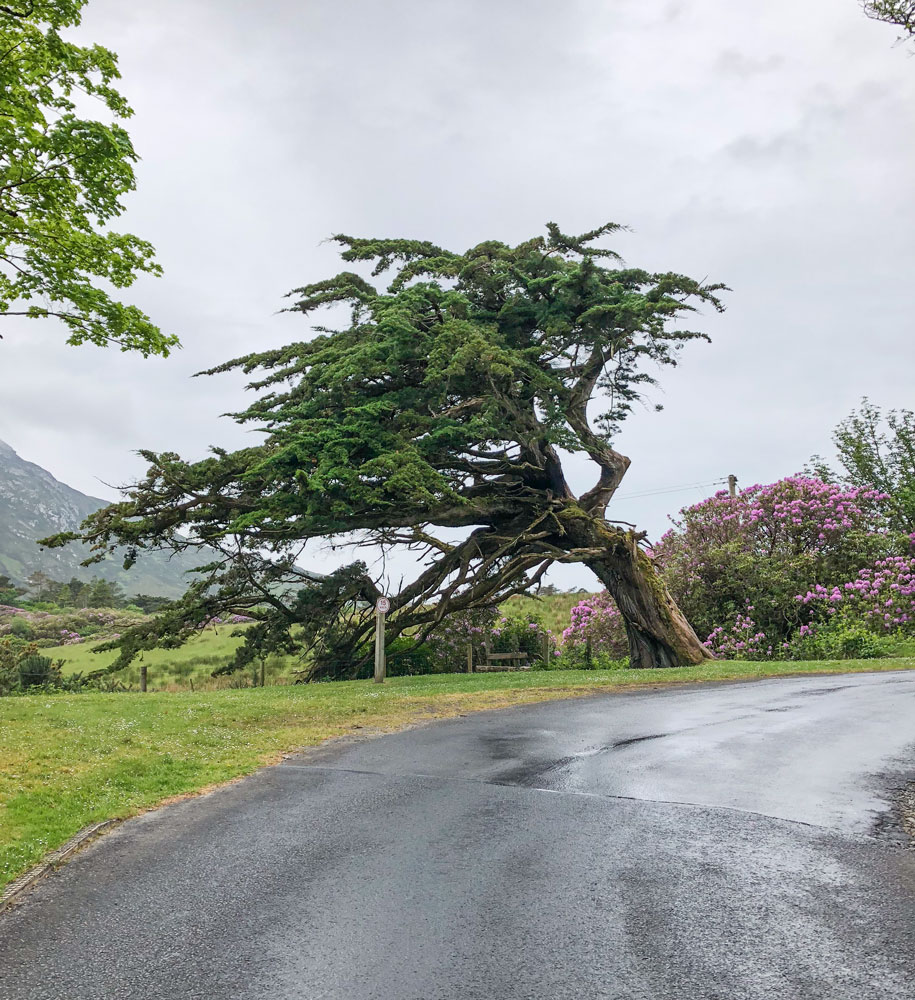
A view of the gardens at Kylemore.
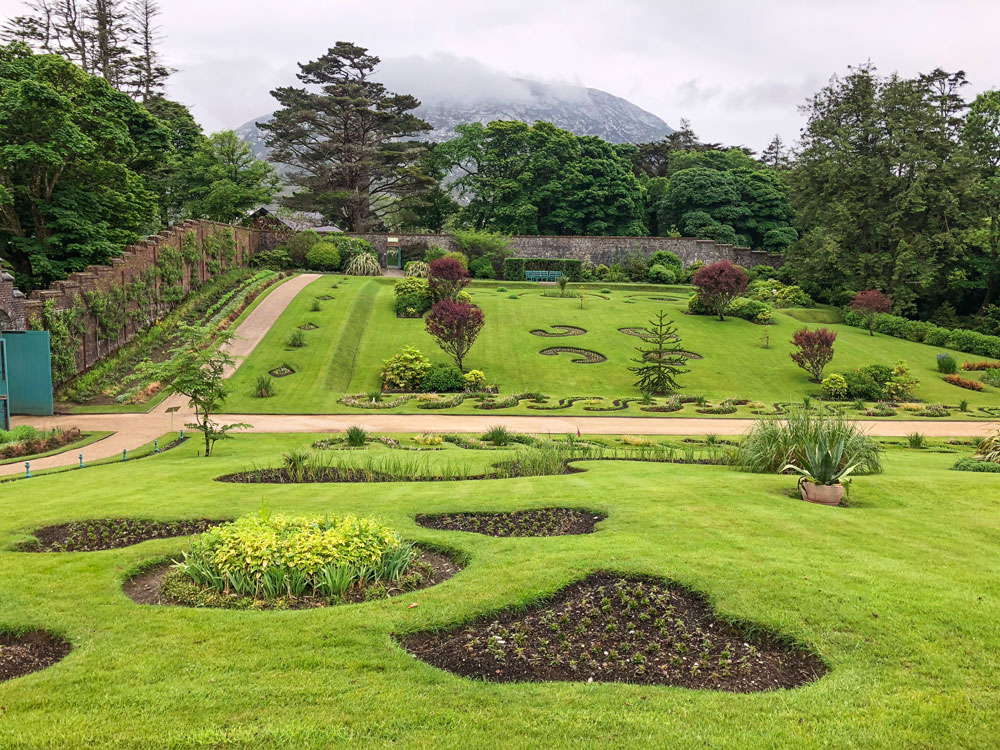
Another garden view.
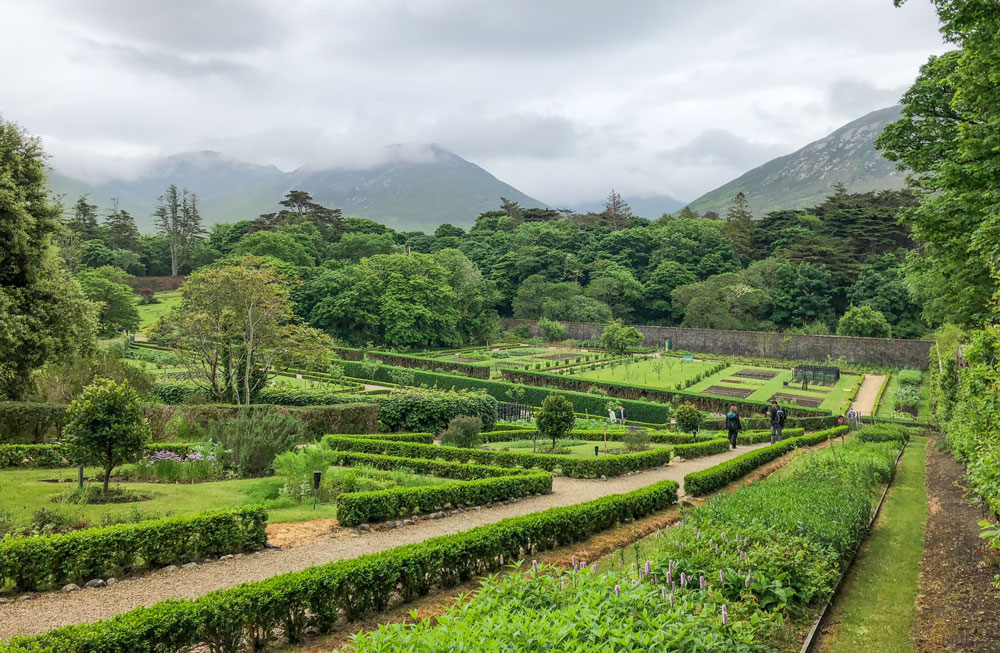
There's a neo-gothic church at Kylemore Abbey, a memorial to Margret Henry, wife of Mitchell Henry. Margret died unexpectedly in 1874, at age 45, and Mitchell commissioned this church in her memory.
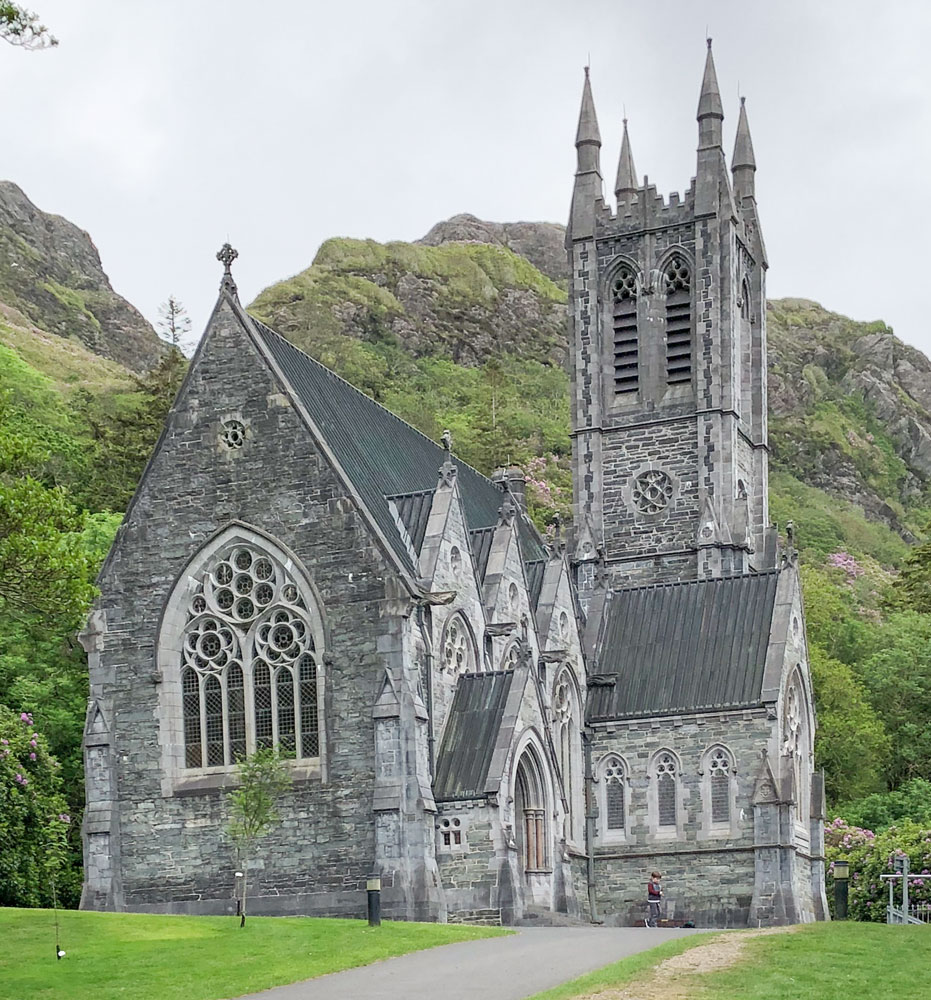
They encountered a Connemara pony while driving back to Glenlo Abbey.
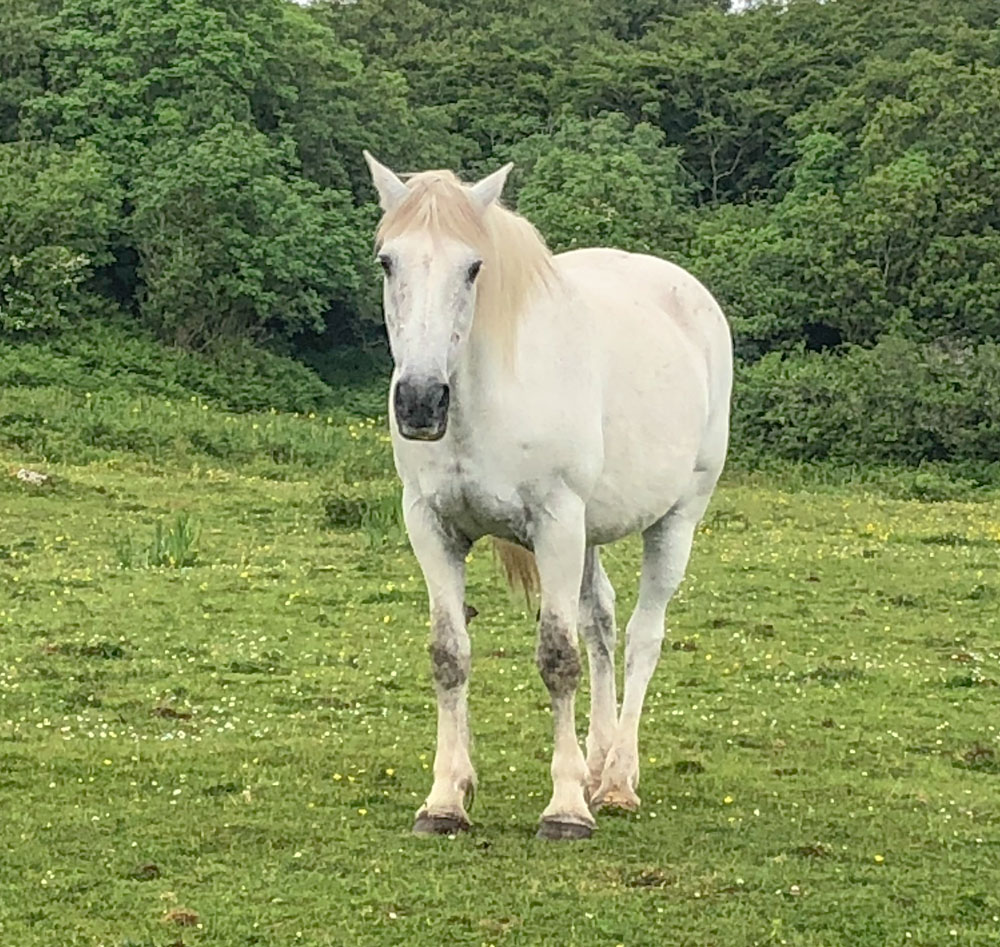
And the horse came looking for affection and treats.
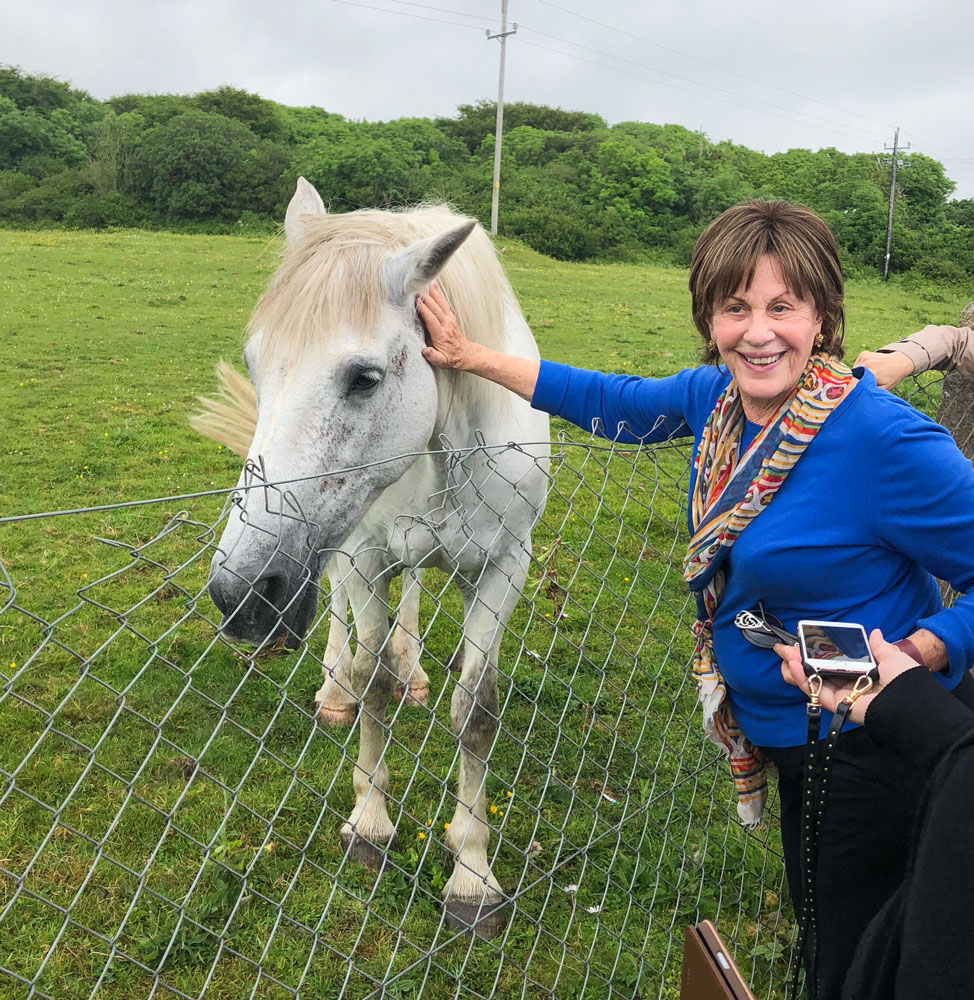
+++++++++++++++++++++++++++++++++++++++++++++++++++++++++++
6/3/2018 (Sunday) Today we depart for Ennis. On the way, we stopped at two places to view the countryside. Here's the first stop.

Judy and I at that first stop.
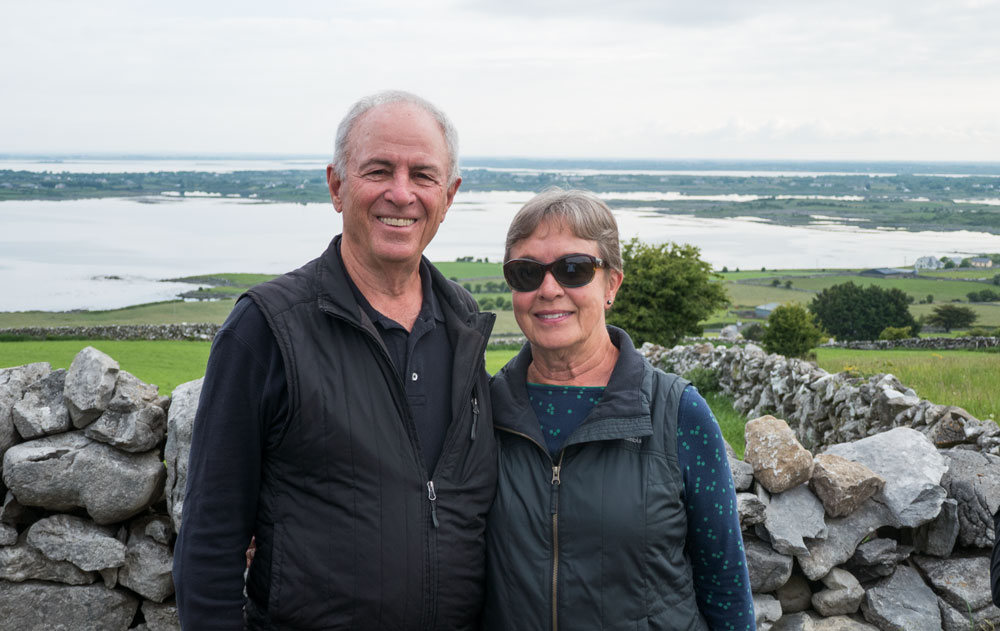
The second stop was on our way to the Cliffs of Moher so we were going up a hill, which gave us a spectacular view of the countryside.
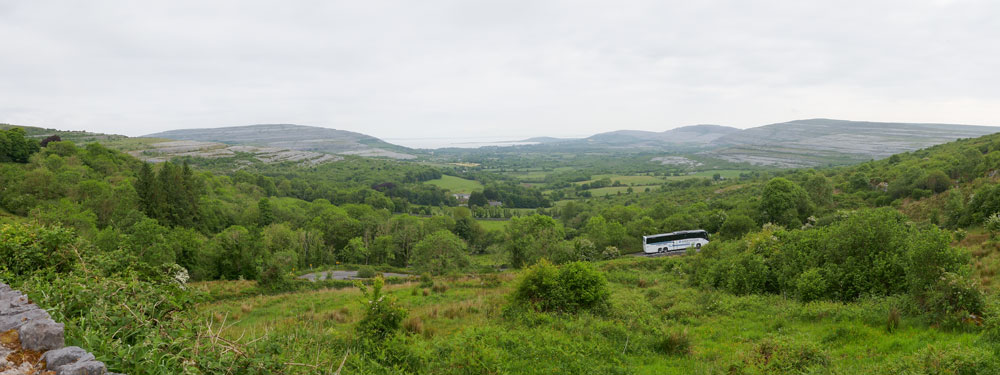
We stopped for a short time in Lisdoorvarna, which is famed for it's "Matchmaking Festival". A music festival associated with the Matchmaking Festival drew up to 40,000 people. The music festival is no longer held because in 1983 it was marred by a riot and the accidental drowning of eight people.
Here's a statue in the town square that celebrates the Matchmaking Festival.

Then we arrived at the Cliffs of Moher. Here's a view of some of the cliffs. It's hard to show, in a picture, the scale of the cliffs. But note O'Brian's Tower, pointed to by the arrow.
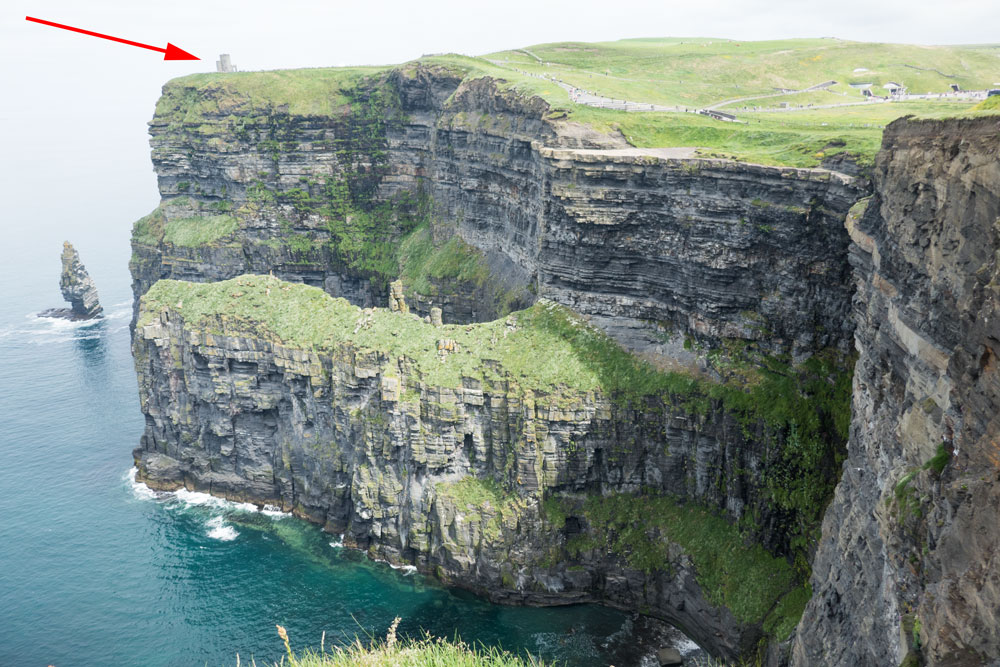
Here's a closer view of O'Brian's Tower and the people around it. The cliffs are over 600 feet high, 702 feet at their highest.

Here's Judy at the Cliffs.
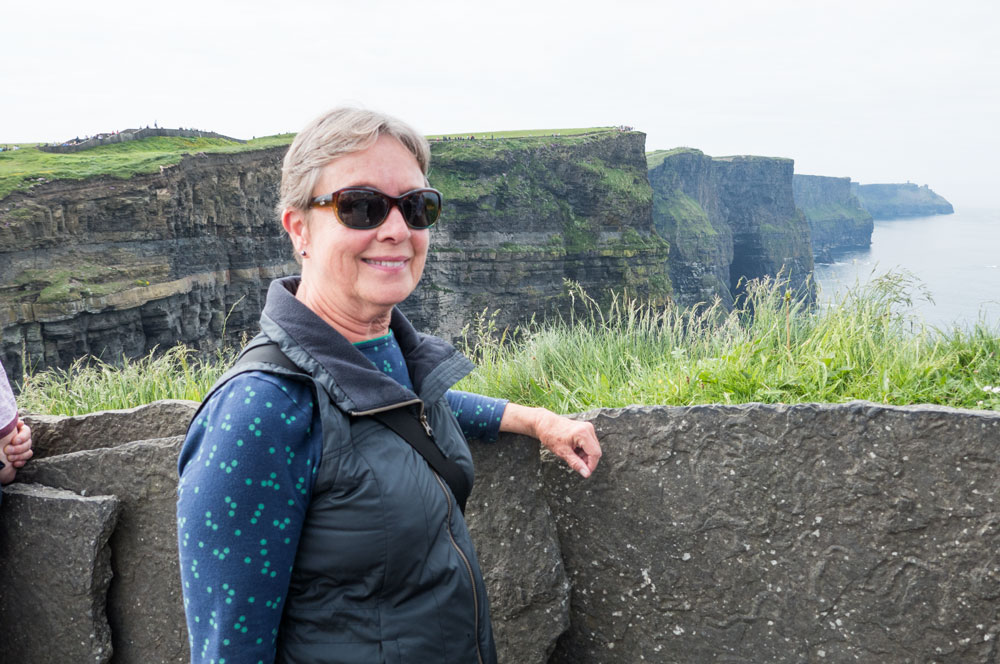
And me.
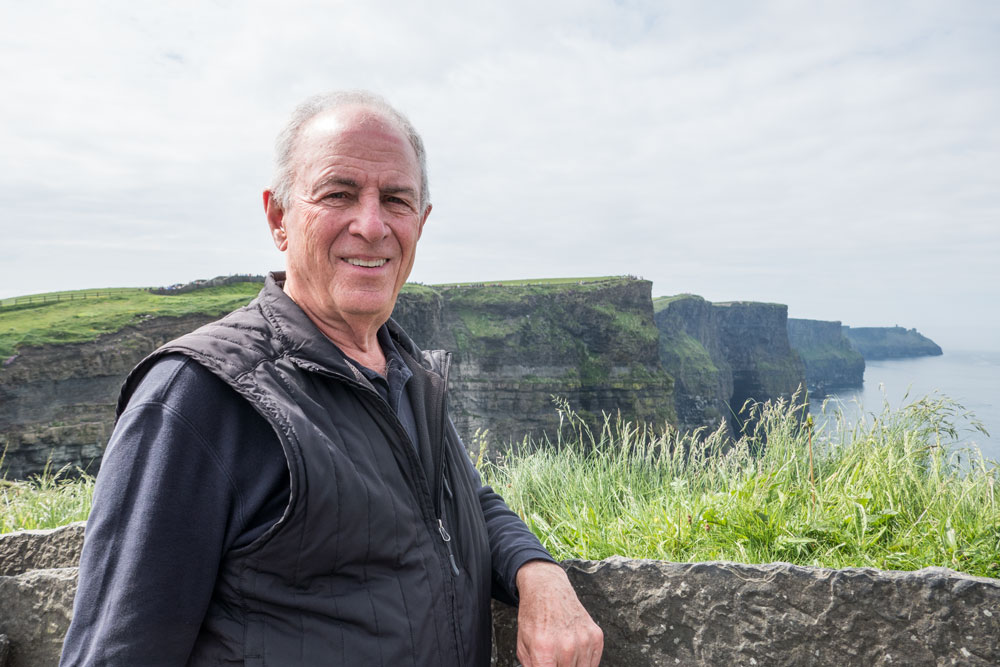
There were some cows grazing on the hills of Moher. Lots of good grass - and cute cows.
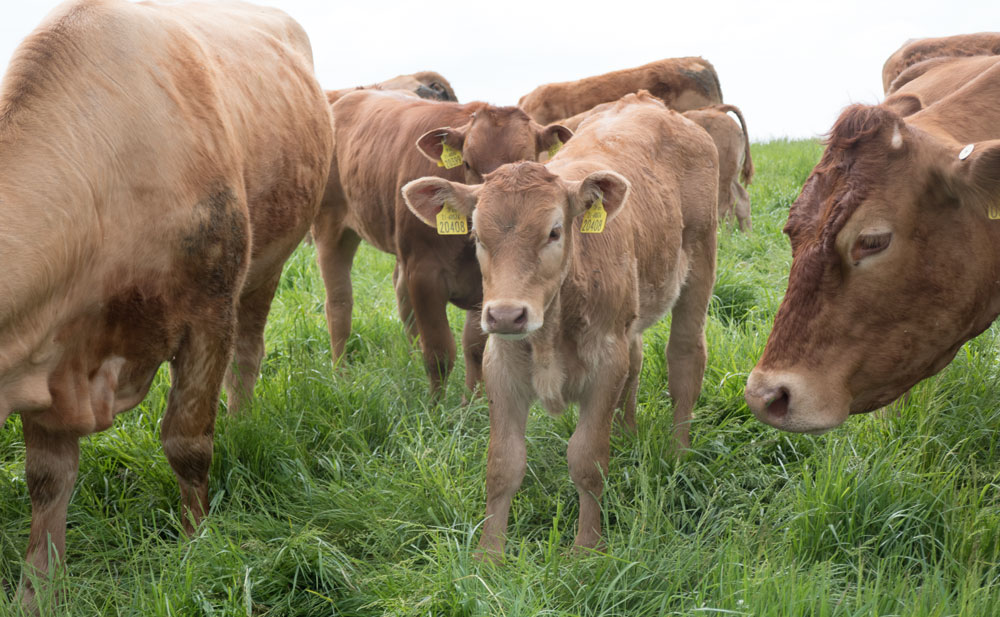
Our last stop on the way to Ennis was at a memorial to the "Great Famine". After Britain conquered Ireland, the land was given to wealthy upper class Englishmen who never went to Ireland but hired overseers to manage their plantations. Britain also enacted the Penal Laws in an attempt to force the Irish Catholics to convert to Protestantism. Those who didn't convert were severely restricted in where they could live and what occupations they could participate in, and they were heavily taxed.
Irish families were allowed to work the land of the plantations, but in serf-like conditions. The overseers exploited the families, who were left on the edge of starvation, surviving on not much else than potatoes. When the Great Famine hit in 1845 (the potato blight) the Irish families essentially had nothing. England did little to help the Irish during the Famine and the overseers used the famine as a way to force families off the land, essentially leaving the families with no food.
Over a million starved. Another million plus emigrated to America, Australia, or Canada. Some had enough assets to cover the cost of the voyage but others went into indentured servitude in exchange for passage. The ships on which they sailed were known as coffin ships, because of the dreadful conditions and high mortality rate.
My great-grandfather, John R. Henderson, emigrated to the US about this time, perhaps because of the famine. He settled in New Orleans and, from what I can tell, did well as a businessman.
We spent some quiet minutes at this memorial.


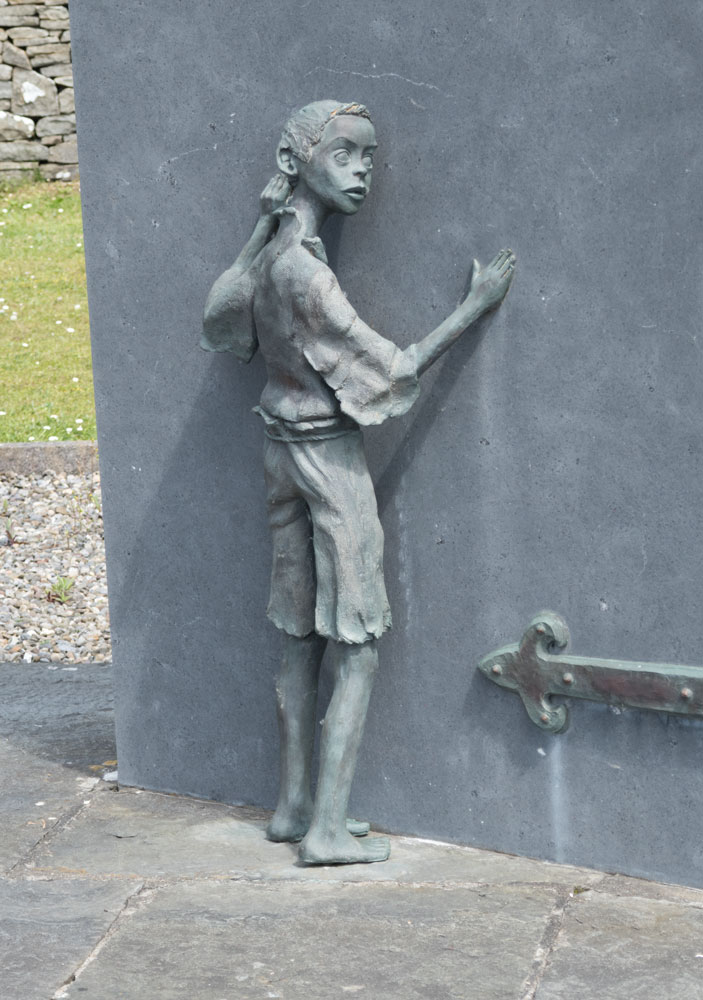
As we were coming into Ennis, we encountered a funeral march. I was told it was for two boys, 15 years old, who drowned while swimming in an abandoned quarry that had filled with water. The young people wearing orange uniforms are members of the rugby team that the boys belonged to.
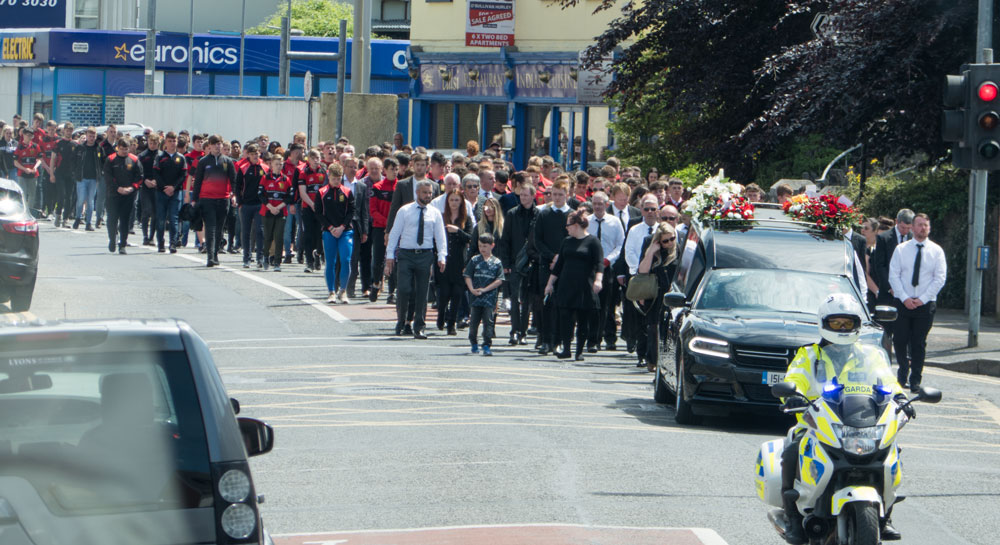
We continued to the Old Ground Hotel, where John displayed his impressive driving skills by backing the bus through the narrow gate. Here's a panoramic picture of the hotel. Judy and I are staying on the top floor of the annex - the windows of our room are indicated by the arrow. It's a very nice room.

It was now about 1:30 so Judy and I went to the Poet's Corner Pub in the hotel and had a bowl of fish chowder. And Judy had a pint of Guinness.
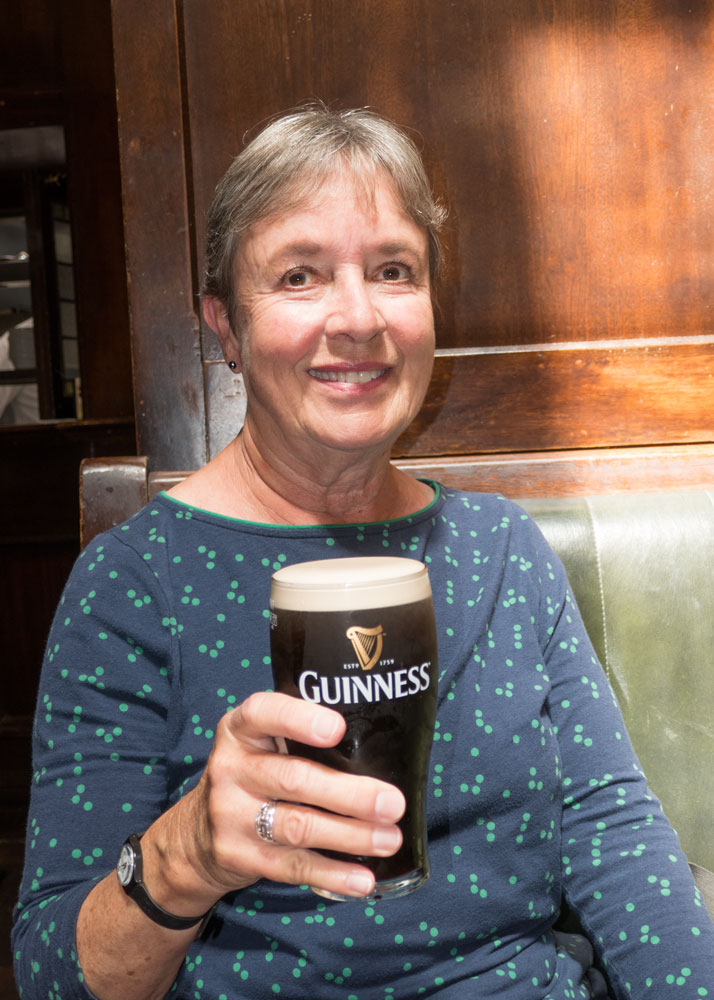
Judy and I wandered around the town and had a cup of coffee in one of the coffee shops.
That evening we had dinner in the ballroom - a very nice room.

There was a young lady playing the Irish harp as we were getting settled. I talked with her between two pieces - she's ten years old! I was really impressed.
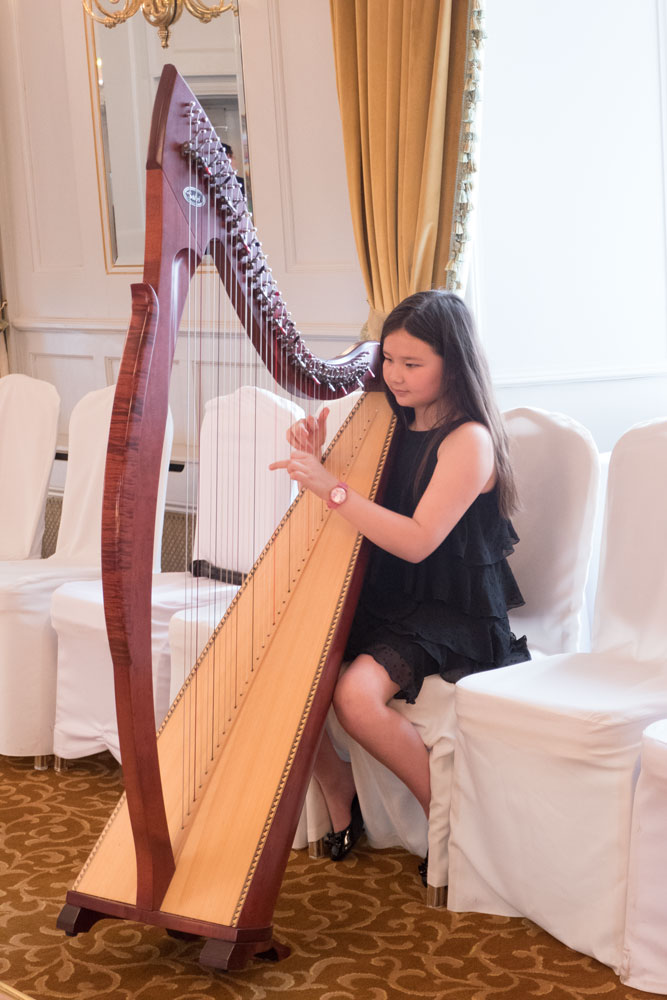
Here's part of our group at dinner.
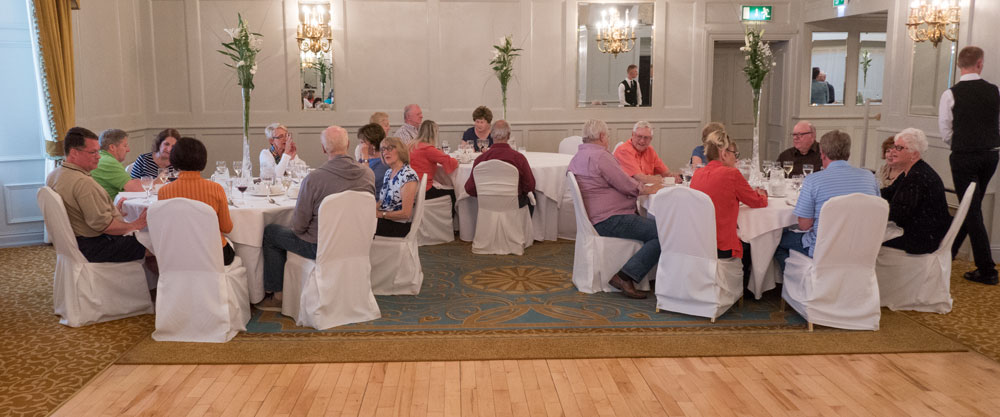
And the rest of the group.

As we were finishing dinner, a group of musicians and dancers came in to entertain us.

The two dancers did several sets of Irish step dancing.
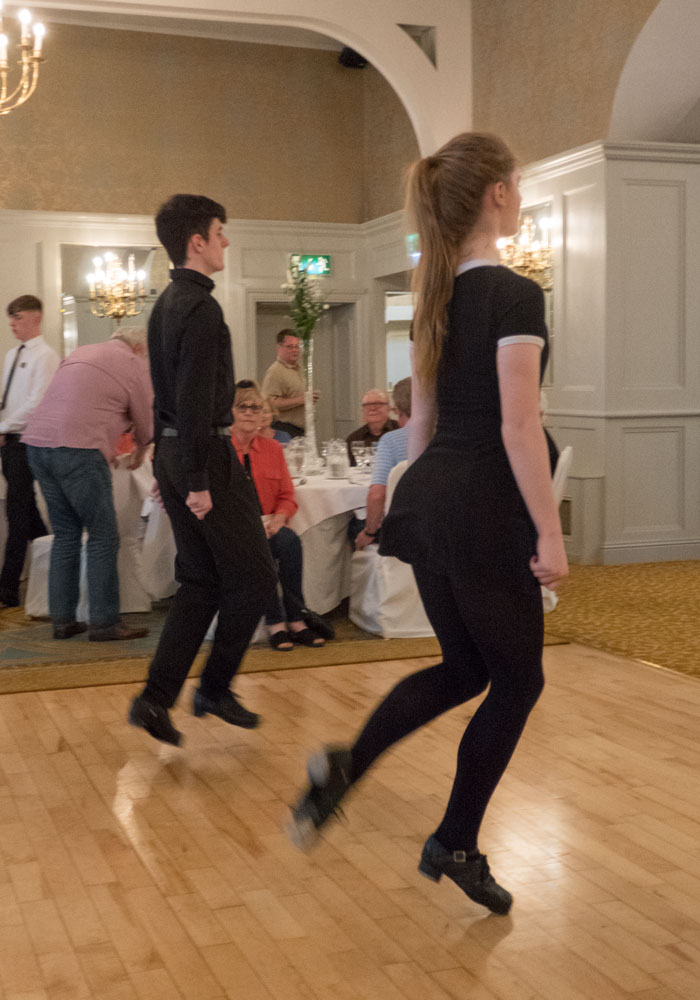
The singer sang several Irish songs.
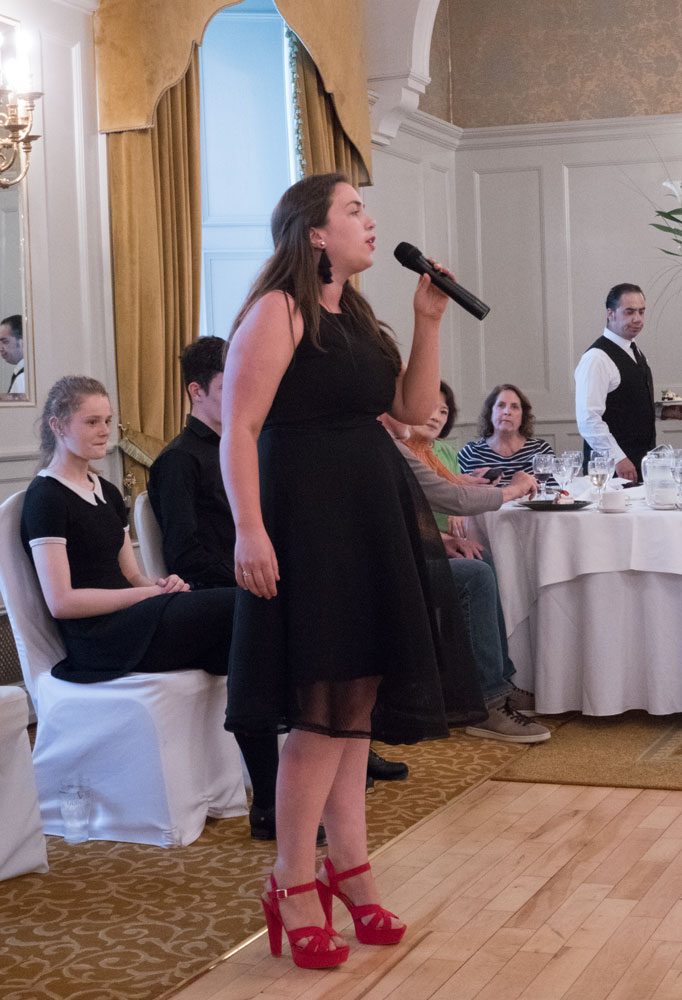
The musicians played several numbers, including a couple of harp solos.
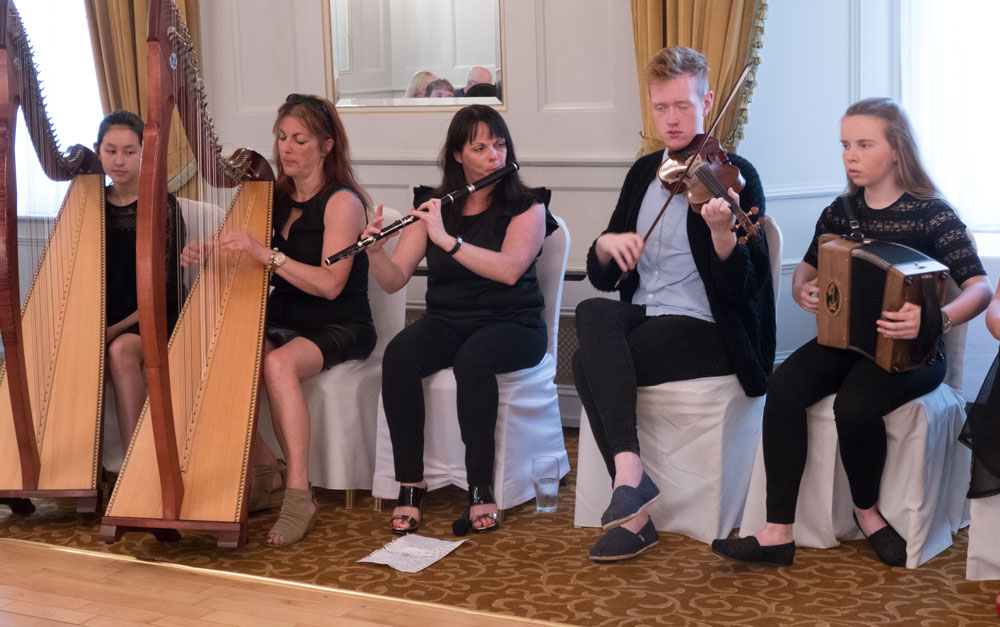
Here's the group after they finished and were getting ready to leave.
